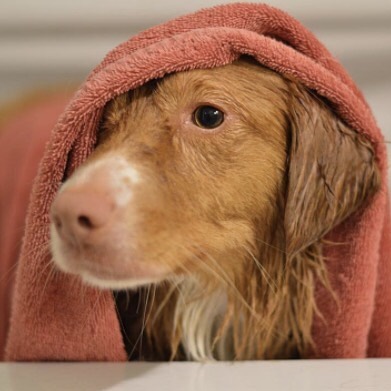As a dog owner, you’re likely familiar with the joy of a freshly bathed pup. Soft skin, bright eyes, and the fluffiest fur on the block. The benefits of bathing aren’t just superficial; keeping your pet clean can also help prevent itching in dogs with allergies and heal inflamed skin and damaged hair.
A trip to the groomer can cost a pretty penny, but many of the tools you need to clean your dog are likely already in your own bathroom. Read on for your very own DIY guide to bathing and grooming your favorite roommate.
First, check the calendar: how often do you actually have to bathe your dog? A general guideline is that most dogs should be bathed at least once a month using dog shampoo or human baby shampoo to prevent their skin from becoming too dry.
Factors like weather and daily activities can affect how often your pet needs to hop in the tub. If you and your dog like to go hiking or swimming during the summer, you may need to plan for a couple of extra baths per month. Your dogs may also appreciate a cool bath every other week in hotter months, especially if they spend a lot of time sweating outdoors.
Before you get to scrubbing, there is some prep required. Begin by brushing your dog – it’ll make bath time a lot easier and more effective. If you’re using a bathtub, put a bath mat down to prevent slipping and fill the tub with about 3 to 4 inches of lukewarm water. Make sure it’s not too hot or too cold!
Once you place your pup in the tub, use a removable shower head or plastic cup to wet his or her fur. Gently apply shampoo until your dog is fully lathered, taking care to avoid the ears, nose, and eyes. Almost done! Make sure you remove all the shampoo before bringing out the towel, as any lingering remnants can lead to skin irritations. Use a towel or gentle blow dryer (make sure it’s on the cool to warm setting – not hot!) to dry your clean dog off. Administer a treat for good behavior.
Campaigning for pet parent of the year? Go the extra mile after bath time and pay attention to those eyes, ears, and nails.
Trimming your dog’s nails is actually not as difficult as you might think. To begin, use a pair of dull children’s scissors to clip any excess fur surrounding your dog’s nails. You’ll need a scissor-type clipper made especially for dogs for the next step.
Separate each individual nail using your finger and clip nails at a 45-degree angle. Clip only small sections of nail at a time, until you see the white inside and a small spot of black inside. Do not go any further than this point, as you can cut the quick and cause your dog to bleed. If this happens, you can use the corn starch at the end of the nail to stop the bleeding.
If your dog tends to get stains or gunk around the eyes, a quick clean will do wonders. To clean around your dog’s eyes, use a damp (and clean) soft sponge or washcloth and gently wipe around the eye area to help loosen and remove any build-up. Avoid using soap or shampoo near their eyes as it could lead to irritations.
Ear cleaning, the last frontier, is trickier than nail and eye cleaning. Dogs’ ears are very sensitive, and one wrong move can cause serious damage. Get your pup accustomed to ear cleaning by slowly associating it with something positive, like fresh treats.
Once your dog is familiar with all the action around his ears, start using cotton balls – not swabs – and a dog-safe ear rinse. Wet the cotton ball with the ear rinse solution and start out wiping the outer part of their ear, followed by the inner section. Make sure not to go too far to avoid potential damage. Add ear cleaning to your weekly roster to prevent any dirt build-up or infections.
With a few key purchases, you’ll be able to keep your dog (and home) cleaner without trekking to a groomer. What are your favorite DIY tricks for grooming your pup?
Image: @mochathetoller









